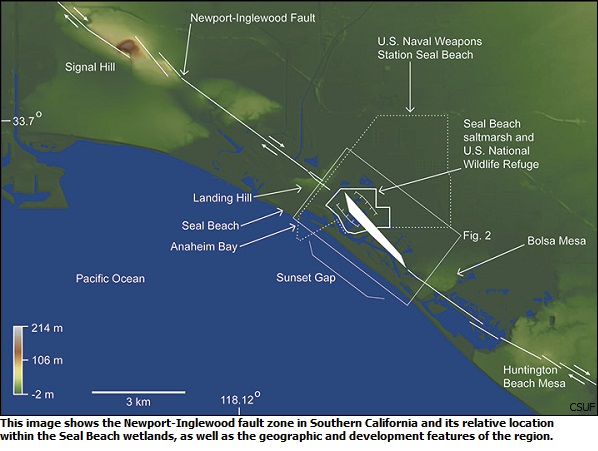
|
|

|
|
| April 20, 2024 |
|
Seal Beach wetlands could sink by 3 feet with a massive quake 
A powerful magnitude 7.0 earthquake or greater could abruptly send the Seal Beach wetlands plummeting by three feet, drastically altering the landscape, according to recent research.
A team of scientists comprised of geologists from Cal State Fullerton and U.S. Geological Survey found that at least three sizable earthquakes rattled the area in the last 2,000 years, resulting in a drop in the land. The last big temblor to cause the land to fall happened about 500 years ago, according to the paper published Monday in the peer-reviewed journal Scientific Reports. The 500-acre coastal salt marsh at the Seal Beach Naval Weapons Station sits atop the Newport-Inglewood/Rose Canyon fault line that stretches from the Los Angeles Basin to San Diego. The wetlands are buffered by the Seal Beach and Huntington Harbour communities, which could be affected by a sinking wetland. Because the area is already at sea level, ocean water would rush in and cover the exposed land, the study said. “The wetlands as we understand it will be submerged. It will be like shallow embayment,” said one of the lead researchers Robert Leeper, a geologist and doctoral student at UC Riverside. “That will be the new state of the wetlands after that earthquake until ... the sediment accumulates over time.” As part of their research, scientists took core samples from the wetlands and discovered something unusual when compared with similar ecosystems in San Diego and Ventura. A strange pancaking of organic peat with vegetation buried by mud and coarse silty sand was found layered in core samples from Seal Beach, Leeper said. “What’s strange is we see evidence for what would be the surface of the wetland buried deep below the wetland today,” said Matthew E. Kirby, a professor of geological sciences at CSU Fullerton and another of the paper’s lead researchers. “We see three periods of time before that. At some point the surface of the wetland sank.” Initially, scientists didn’t set out to see how the wetlands could be impacted by an earthquake. Instead, they were looking for evidence of historic tsunamis off California’s coast after the 2004 Indian Ocean earthquake that rocked Sri Lanka and Thailand, killing an estimated 230,000 people and displacing 1.7 million people in 14 countries. But upon taking core samples, they found Seal Beach stood out when compared with wetlands in Point Mugu in Ventura and the Los Penasquitos wetland in San Diego. The wetlands could stay below sea level for decades but gradually, over time, sediment would be deposited by storms and floods, rebuilding the wetland, they said. “This disturbance might last for hundreds of years,” Kirby said. “But the wetland will return to being a wetland.” (Source: The Orange County Register) Story Date: April 1, 2017
|